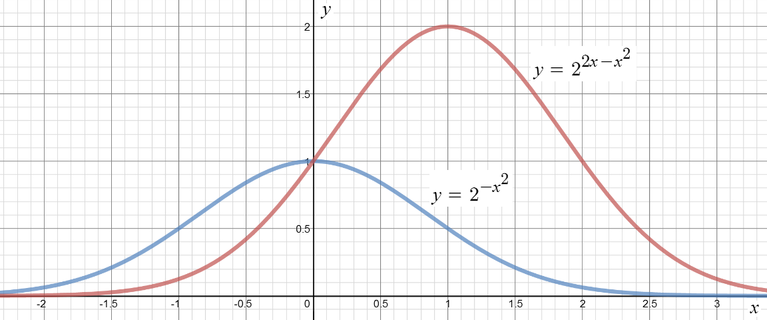- The graph \(y = f(x)\) of a certain function has been plotted below.

On the next three pairs of axes (A), (B), (C) are graphs of \[y = f(-x), \quad f(x-1), \quad -f(x)\] in some order. Say which axes correspond to which graphs.

|

|

|
Graph (A) is \(-f(x)\), since the graph has been reflected in the \(x\)-axis.
Graph (B) is \(f(-x)\), since the graph has been reflected in the \(y\)-axis.
Graph (C) is \(f(x-1)\), since the graph has been translated (one unit) to the right.
- Sketch graphs of both of the following functions \[y = 2^{-x^2} \quad \text{and} \quad y = 2^{2x - x^2}.\] Carefully label any stationary points.

We sketch \(y = 2^{-x^2}\) by noticing that it must be symmetrical about the \(y\)-axis. It takes its largest value of \(1\) at \(x = 0\), and decreases to zero as the magnitude of \(x\) increases.
For the second graph, we note that \[y = 2^{2x - x^2} = 2^{1-1 + 2x - x^2} = 2^{1-(x-1)^2}= 2 \times 2^{-(x-1)^2},\] and so this graph is \(y = 2^{-x^2}\) translated to the right by one unit and stretched vertically by a factor of two.
- Let \(c\) be a real number and define the following integral \[I(c) = \int^1_0 2^{-(x-c)^2} dx.\]
State the value(s) of \(c\) for which \(I(c)\) is largest. Briefly explain your reasoning. [Note you are not being asked to calculate this maximum value.]
The graph of \(2^{-(x-c)^2}\) is the graph of \(2^{-x^2}\) translated \(c\) units to the right.
The integral \(I(c)\) corresponds to the area under that graph within the range \(0 \le x \le 1\).
To maximise this, we should choose \(c\) so that the highest point of the graph is in the middle of this range, at \(x = \dfrac{1}{2}\), which occurs when \(c = \dfrac{1}{2}\).

